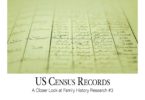The next natural step for a beginning genealogist is to start using vital records. You can use the information you already know, plus the information you gathered with your family interviews to look up people in the vital records. This is important, because not only can vital records confirm information you thought you knew or that you received from a relative (or let you know if a bit or all of it was possibly incorrect), you can also get new pieces of information that your knowledge and interviews may have missed, such as dates and places.
Most importantly, vital records can help you connect one generation to the next, with a verified paper trail, and can let you know the names of the previous generation. This gives you a whole new generation to explore that is farther back in your family tree.
What are vital records? They are any type of record that provides personal information about a person. Things such as military records and baptismal records can be considered vital records. However, when it comes to genealogy, there are the Big Three in vital records, which are the three foundational and most important vital records for you to use, especially when you are just beginning. These are Birth, Death, and Marriage records.
Birth records obviously give you the full name of the person being born, including the sometimes elusive middle name. They also give you the names of the parents, including the often elusive maiden name of the mother. They may also provide you with the ages of the parents at the birth of the child, the place and time the child was born, whether it was a single birth or twins, triplets, etc. (especially if you never knew that person had a twin or other siblings born at the same time as them), and, with older birth records, whether the child was born in wedlock or not.
Death records are also important sources of information about a person. You can find all kinds of useful genealogical information on them. The birthdate and death date of the person on the certificate, their marital status, what they did for a living, place of death, cause of death (in older death certificates, as some states have moratoriums on anyone but close family members accessing this information before a certain number of decades have gone by), the name of the informant (who could be a relative, but not always), the place of burial (if any), and, the most prized information, the names of the parents and their birthplaces. The parents’ names are not always included, especially if the informant did not know them, or the decedent did not want this information revealed for some reason, but when they are there, those names give you a jumping off point to research the previous generation.
As for marriage records, the information included depends on the time period and the state. You may find just the names of the couple. You may also find the names of their witnesses (who are sometimes relatives), the names of their parents, the ages of the couple, where each one is from, the name of the minister or officiant who married them, and the number of previous marriages for each person, if any. All excellent information.



